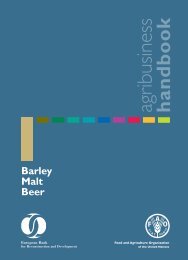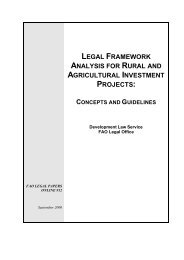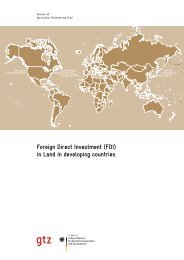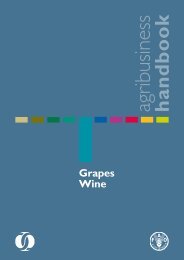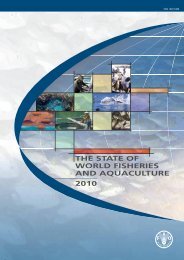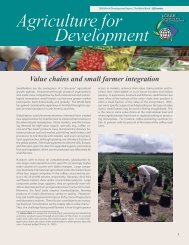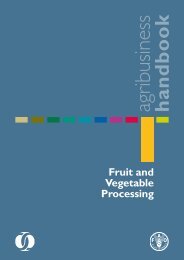Agribusiness Handbook: Milk / Dairy Products - FAO
Agribusiness Handbook: Milk / Dairy Products - FAO
Agribusiness Handbook: Milk / Dairy Products - FAO
Create successful ePaper yourself
Turn your PDF publications into a flip-book with our unique Google optimized e-Paper software.
Figure 3: Development of cattle ownership, Tajikistan<br />
1,000 heads<br />
1,600<br />
1,400<br />
1,200<br />
1,000<br />
800<br />
600<br />
400<br />
200<br />
0<br />
1991 1997 2000 2001 2002 2003 2004<br />
State farms Derkhan farms Households<br />
Source: World Bank, 2005, based on National Statistics of Tajikistan<br />
The proportion of cows in the dairy herd has also increased, from 38% in 1988<br />
to 52% in 2003, reflecting the increased importance placed on dairy production.<br />
Most of the increase in the number of cattle occurred at the households level,<br />
with households owning 87% of the national herd. Only 3% of cattle are<br />
held by private dekhan farms (small farm units with fewer than 50 animals,<br />
created by splitting up kolkhozes and sovkhozes) and 10% by state farms.<br />
The privatization of state cattle farms was complicated by the indivisibility of<br />
fixed assets such as buildings and milking equipment and by other issues<br />
related to the decline of management skills in the agriculture sector. A World<br />
Bank assessment of livestock production, conducted in 2005, estimates the<br />
average annual milk production at 1,200 litres per cow on dekhan and state<br />
farms, compared with only 600 litres per cow on household farms. Although<br />
dekhan and state farms account for only 13% of total milk production, 36% of<br />
total marketed milk comes from these farms. Most of their production is sold<br />
to larger processors.<br />
Two groups of dairy processing plants can be distinguished. The first group<br />
consists of relatively large (processing capacities of 1,500 to 10,000 litres per<br />
day) usually state- or privately-owned factories. Processing equipment usually<br />
dates back to Soviet times. These processing plants do not buy the milk from<br />
household farms, but instead contract with bigger dehkans and state farms<br />
for defined quantities of milk per day, sending their vehicles to collect the milk.<br />
The second group of dairy processors consists of semi-industrial plants with<br />
smaller capacities. These companies have been established in recent years,<br />
mostly in urban centres. Collecting 200 to 500 litres of milk per day, either directly<br />
from producers or from traders, they produce ice cream, cheese or traditional<br />
39



